Belize
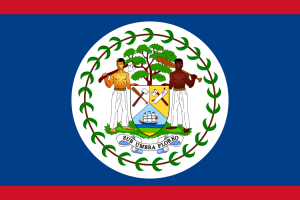
Belize and the Maya History
Although Belize’s Maya occupation began as early as 1500 BC, it was during the Classic period of 250 AD to 900 AD that the population is thought to have exceeded one million people. Archaeological remains of the ancient Maya include pottery, skeletons, stelae, and tall palaces, temples, and ceremonial centers.
Belize ![]() i/bəˈliːz/ is a country on the northeastern coast of Central America. It is the only country in the area that has English as the official language, though an English creole (Kriol) and Spanish are more commonly spoken. Belize is bordered on the north by Mexico, to the south and west by Guatemala, and to the east by the Caribbean Sea. Its mainland is about 290 km (180 mi) long and 110 km (68 mi) wide.
i/bəˈliːz/ is a country on the northeastern coast of Central America. It is the only country in the area that has English as the official language, though an English creole (Kriol) and Spanish are more commonly spoken. Belize is bordered on the north by Mexico, to the south and west by Guatemala, and to the east by the Caribbean Sea. Its mainland is about 290 km (180 mi) long and 110 km (68 mi) wide.
With 22,800 square kilometres (8,800 sq mi) of land and a population of only 334,297 (2013 est.), Belize has the lowest population density in Central America. The country’s population growth rate of 1.97% per year (2013) is the second highest in the region and one of the highest in the western hemisphere.
Belize’s abundance of terrestrial and marine species and its diversity of ecosystems give it a key place in the globally significant Mesoamerican Biological Corridor.
Belize has a diverse society, with many cultures and languages. Originally part of the British Empire, it shares a common colonial history with other Anglophone Caribbean countries. From 1862 to 1973, its name was British Honduras. It became an independent Commonwealth realm in 1981, retaining Queen Elizabeth II as head of state.
In general, Belize is considered a Central American and Caribbean nation with strong ties to the entire Latin American and Caribbean region. Belize is a member of the Caribbean Community (CARICOM), the Community of Latin American and Caribbean States (CELAC), and the Central American Integration System (SICA), the only country to hold full membership in all three regional organizations.
Belize is known for its September Celebrations, and is the birthplace of chewing gum and Punta music.
Etymology
The origin of the name Belize is unclear, but the earliest record of the name is found in the journal of the Dominican priest Fray José Delgado, dating to 1677. Delgado recorded the names of three major rivers that he crossed while traveling north along the Caribbean coast: Rio Soyte, Rio Xibum, and Rio Balis. These names, which correspond to the Sittee River, Sibun River, andBelize River, were provided to Delgado by his translator. It is likely that Delgado’s “Balis” was actually the Mayan word belix (orbeliz), meaning “muddy-watered.”
Others have suggested that the name is derived from a Spanish pronunciation of the name of the Scottish buccaneer Peter Wallace, which was applied to an early settlement at the mouth of the Belize River, although there is no proof that Wallace actually settled in the area and some have characterized this claim as a myth. Several other possible etymologies have been suggested by writers and historians, including French and African origins.
History of Belize and Pre-Columbian Belize
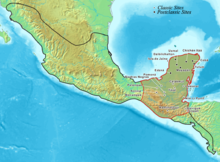 Extent of the Maya Civilization
Extent of the Maya Civilization
The Maya civilization emerged at least three millennia ago in the lowland area of the Yucatán Peninsula and the highlands to the south, in what is now southeastern Mexico, Belize, Guatemala, and western Honduras. Many aspects of this culture persist in the area despite nearly 500 years of European domination. Prior to about 2500 BCE, some hunting and foraging bands settled in small farming villages; they later domesticated crops such as corn, beans, squash, and chili peppers.
A profusion of languages and subcultures developed within the Maya core culture. Between about 2500 BCE. and 250 CE, the basic institutions of Maya civilization emerged. The peak of this civilization occurred during the classic period, which began about 250 CE.
The recorded history of the center and south is dominated by Caracol, where the inscriptions on their monuments was, as elsewhere, in the Lowland Maya aristocratic tongue Classic Ch’olti’an. North of the Maya Mountains, the inscriptional language at Lamanai was Yucatecan as of 625 CE. The last date recorded in Ch’olti’an within Belizean borders is 859 CE in Caracol, stele 10. Yucatec civilisation, in Lamanai, lasted longer.
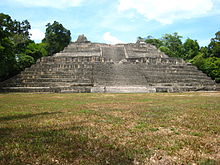 “Caana” at Caracol
“Caana” at Caracol
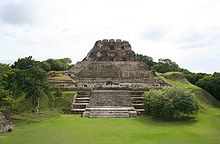 “El Castillo” at Xunantunich
“El Castillo” at Xunantunich
The Maya civilization spread itself over what is now Belize beginning in around 1500 BCE, and flourished there until about 800 CE. The recorded history of the centre and south is dominated by Caracol, where the inscriptions on their monuments were, as elsewhere, in the Lowland Maya aristocratic tongue Classic Ch’olti’an. North of the Maya Mountains, the inscriptional language at Lamanai was Yucatecan as of CE 625.
In the late classic period of Maya civilization (before 1000 BCE), as many as 400,000 people may have lived in the area that is now Belize. Some lowland Maya still occupied the area when Europeans arrived in the 16th century. By then the primary inhabitants were the Mopan branch of the Yucatec Maya.
Colonial History
Spanish conquistadors explored the land and declared it a Spanish colony but chose not to settle because of the lack of resources such as gold and the strong defence of the Yucatán by the Maya. Later English and Scottish settlers and pirates known as the Baymen entered the area in the 17th and 18th century respectively and established a logwood trade colony, slave economy and port in what would become the Belize District. Baymen first settled on the coast of what is now Belize in 1638, seeking a sheltered region from which they could attack Spanish ships (see English settlement in Belize). The settlers turned to cutting logwood during the 18th century, establishing a system of slave labour using Black slaves. The wood yielded a fixing agent for clothing dyes that was vital to the European woollen industry. The Spanish granted the British settlers the right to occupy the area and cut logwood in exchange for an end to piracy.
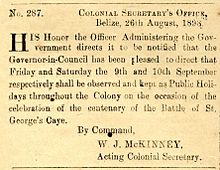 An excerpt from the 1898 Gazette that declared 10 September an official holiday, part of the efforts of the Centennial Committee
An excerpt from the 1898 Gazette that declared 10 September an official holiday, part of the efforts of the Centennial Committee
The Battle of St. George’s Caye refers to a military engagement off the coast of what is now Belize that is said to have lasted from 3–10 September 1798. But the name is typically reserved for the final battle that allegedly occurred on 10 September. The British first appointed a superintendent over the Belize area in 1786. Before then, the British government had not recognized the settlement as a colony for fear of provoking a Spanish attack. The delay in government oversight allowed the settlers to establish their own laws and forms of government. During this period, a few wealthy settlers gained control of the local legislature, known as the Public Meeting, as well as of most of the settlement’s land and timber.
Accounts of the battle describe an engagement between an invading force from what would become Mexico, attempting to capture the Baymen controlled territory for Spain from a small force of Baymen and their Black slaves.
The Spanish are said to have repeatedly and unsuccessfully tried to gain control over the territory by force. Contemporary accounts mention that Spain’s last attempt occurred on 10 September 1798, when the Baymen and their Black slaves repelled the Spanish fleet in a short engagement with no known casualties on either side, known as the Battle of St. George’s Caye. The anniversary of the battle is a national holiday in Belize and is celebrated by some Belizeans to commemorate the “first Belizeans” and their defence of the territory.
As part of the British Empire
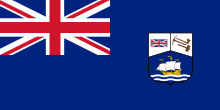 Flag of British Honduras
Flag of British Honduras
In the early 19th century, the British sought greater control over the settlers, threatening to suspend the Public Meeting unless it observed the government’s instructions to eliminate slavery in whole. Slavery was abolished in the British Empire in 1838, but this did little to change working conditions for labourers in the Belize settlement.
Slaves of the colony were valued for their potentially superior abilities in the work of mahogany extraction. As a result, former slave owners in British Honduras earned £53.69 on average per slave, the highest amount paid in any British territory.
Soon after, a series of institutions were put in place to ensure the continued presence of a viable labour force. Some of these greatly restricted the ability of individuals to obtain land, in a debt-peonage system to organise the newly “free.” The position of being “extra special” mahogany and logwood cutters undergirded the early ascriptions of the capacities (and consequently the limitations) of people of African descent in the colony. Because a small elite controlled the settlement’s land and commerce, former slaves had no choice but to continue to work in timber cutting.
In 1836, after the emancipation of Central America from Spanish rule, the British claimed the right to administer the region. In 1862, Great Britain formally declared it a British Crown Colony, subordinate to Jamaica, and named it British Honduras.
As a colony, Belize began to attract British investors. Among the British firms that dominated the colony in the late 19th century was the Belize Estate and Produce Company, which eventually acquired half of all the privately held land in the colony. Belize Estate’s influence accounts in part for the colony’s reliance on the mahogany trade throughout the rest of the 19th century and the first half of the 20th century.
 Panoramic view of Belize City, c. 1914
Panoramic view of Belize City, c. 1914
The Great Depression of the 1930’s caused a near-collapse of the colonial economy as British demand for timber plummeted. The effects of widespread unemployment were worsened by a devastating hurricane that struck the colony in 1931. Perceptions of the government’s relief effort as inadequate were aggravated by its refusal to legalize labour unions or introduce a minimum wage. Economic conditions improved during World War II (1939–1945) when many Belizean men entered the armed forces or otherwise contributed labour to the war effort.
Following the war, the colony’s economy again stagnated because of the pressures caused by its damaging effect. Britain’s decision to devalue the British Honduras dollar in 1949 worsened economic conditions and led to the creation of the People’s Committee, which demanded independence. The People’s Committee’s successor, the People’s United Party (PUP), sought constitutional reforms that would expand voting rights to all adults.
Independence
Constitutional reforms were initiated in 1954 and resulted in a new constitution ten years later. Britain granted British Honduras self-government in 1964, and the head of the PUP—independence leader George Price—became the colony’s prime minister. British Honduras was officially renamed Belize in 1973.
Progress toward independence, however, was hampered by a Guatemalan claim to sovereignty over the territory of Belize. While Belize finally attained independence on 21 September 1981, about 1,500 British troops remained in Belize, the declared purpose being to provide protection from a Guatemalan threat. Guatemala had refused to recognise the new nation because of its longstanding territorial dispute with the British.
With Price at the helm, the PUP won all elections until 1984. In that election, the first national election after independence, the PUP was defeated by the United Democratic Party (UDP), and UDP leader Manuel Esquivel replaced Price as prime minister. Price returned to power after elections in 1989. Guatemala’s president formally recognised Belize’s independence in 1992. The following year the United Kingdom announced that it would end its military involvement in Belize. British soldiers were withdrawn in 1994, but the United Kingdom left behind a military training unit to assist with the newly formed Belize Defence Force.
The UDP regained power in the 1993 national election, and Esquivel became prime minister for a second time. Soon afterwards Esquivel announced the suspension of a pact reached with Guatemala during Price’s tenure, claiming Price had made too many concessions to gain Guatemalan recognition. The pact may have curtailed the 130-year-old border dispute between the two countries. Border tensions continued into the early 2000s, although the two countries cooperated in other areas.
The PUP won a landslide victory in the 1998 national elections, and PUP leader Said Musa was sworn in as prime minister. In the 2003 elections the PUP maintained its majority, and Musa continued as prime minister. He pledged to improve conditions in the underdeveloped and largely inaccessible southern part of Belize.
In 2005, Belize was the site of unrest caused by discontent with the People’s United Party government, including tax increases in the national budget. On 8 February 2008, Dean Barrow was sworn in as prime minister after his UDP won a landslide victory in general elections.
Throughout Belize’s history, Guatemala has claimed ownership of all or part of the territory. This claim is occasionally reflected in maps showing Belize as Guatemala’s twenty-third department. As of February 2012, the border dispute with Guatemala remains unresolved and quite contentious.
Guatemala’s claim to Belizean territory rests, in part, on Clause VII of the Anglo-Guatemalan Treaty of 1859, which obligated the British to build a road between Belize City and Guatemala. At various times the issue has required mediation by the United Kingdom, Caribbean Community heads of Government, the Organization of American States, Mexico, and the United States. Notably, both Guatemala and Belize participate in confidence-building measures approved by the OAS, including the Guatemala-Belize Language Exchange Project.


